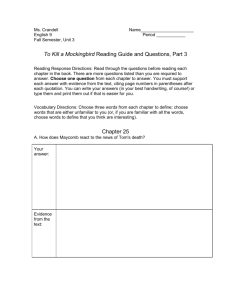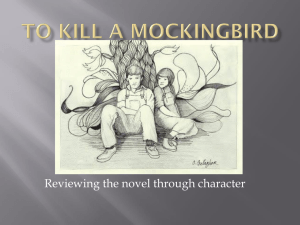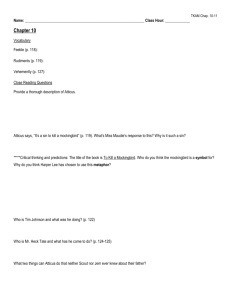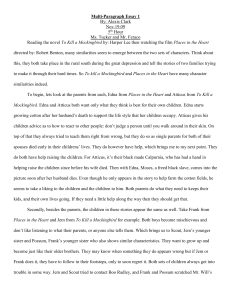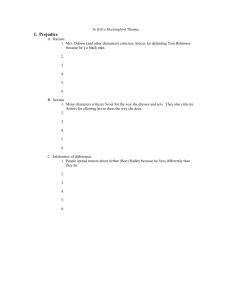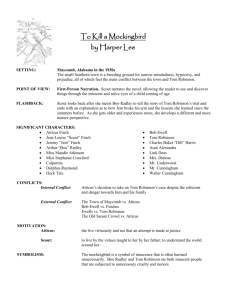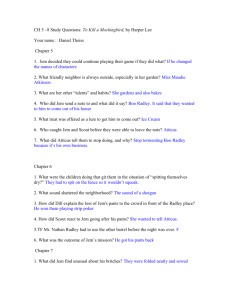Mockingbirds
advertisement
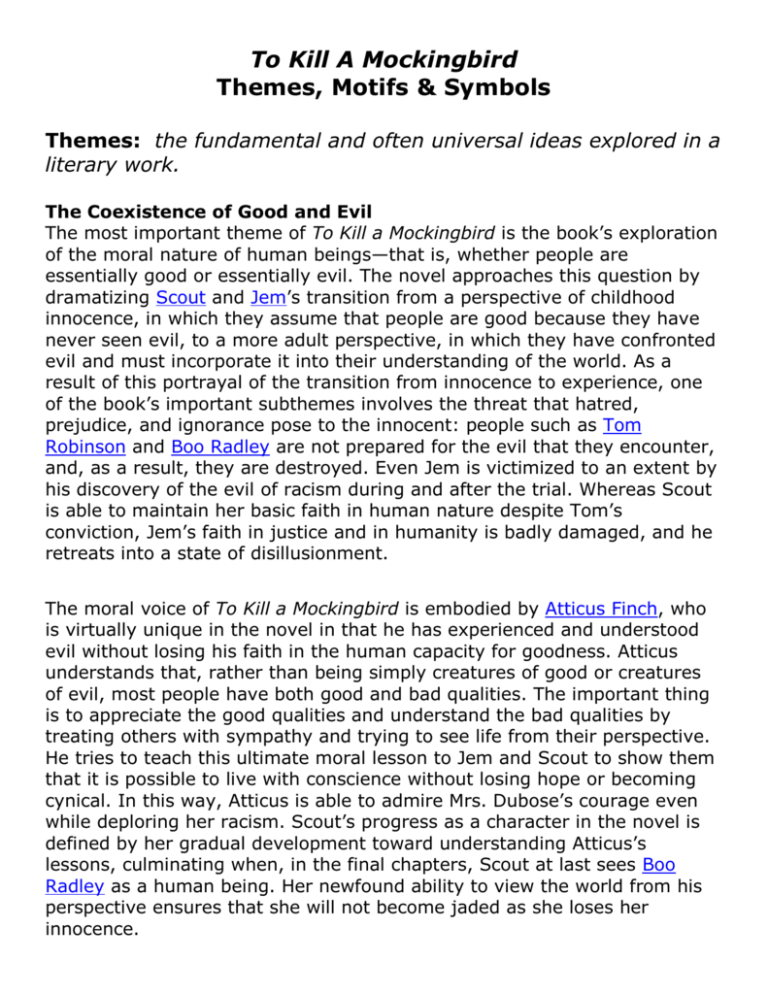
To Kill A Mockingbird Themes, Motifs & Symbols Themes: the fundamental and often universal ideas explored in a literary work. The Coexistence of Good and Evil The most important theme of To Kill a Mockingbird is the book’s exploration of the moral nature of human beings—that is, whether people are essentially good or essentially evil. The novel approaches this question by dramatizing Scout and Jem’s transition from a perspective of childhood innocence, in which they assume that people are good because they have never seen evil, to a more adult perspective, in which they have confronted evil and must incorporate it into their understanding of the world. As a result of this portrayal of the transition from innocence to experience, one of the book’s important subthemes involves the threat that hatred, prejudice, and ignorance pose to the innocent: people such as Tom Robinson and Boo Radley are not prepared for the evil that they encounter, and, as a result, they are destroyed. Even Jem is victimized to an extent by his discovery of the evil of racism during and after the trial. Whereas Scout is able to maintain her basic faith in human nature despite Tom’s conviction, Jem’s faith in justice and in humanity is badly damaged, and he retreats into a state of disillusionment. The moral voice of To Kill a Mockingbird is embodied by Atticus Finch, who is virtually unique in the novel in that he has experienced and understood evil without losing his faith in the human capacity for goodness. Atticus understands that, rather than being simply creatures of good or creatures of evil, most people have both good and bad qualities. The important thing is to appreciate the good qualities and understand the bad qualities by treating others with sympathy and trying to see life from their perspective. He tries to teach this ultimate moral lesson to Jem and Scout to show them that it is possible to live with conscience without losing hope or becoming cynical. In this way, Atticus is able to admire Mrs. Dubose’s courage even while deploring her racism. Scout’s progress as a character in the novel is defined by her gradual development toward understanding Atticus’s lessons, culminating when, in the final chapters, Scout at last sees Boo Radley as a human being. Her newfound ability to view the world from his perspective ensures that she will not become jaded as she loses her innocence. The Existence of Social Inequality Differences in social status are explored largely through the overcomplicated social hierarchy of Maycomb, the ins and outs of which constantly baffle the children. The relatively well-off Finches stand near the top of Maycomb’s social hierarchy, with most of the townspeople beneath them. Ignorant country farmers like the Cunninghams lie below the townspeople, and the white trash Ewells rest below the Cunninghams. But the black community in Maycomb, despite its abundance of admirable qualities, squats below even the Ewells, enabling Bob Ewell to make up for his own lack of importance by persecuting Tom Robinson. These rigid social divisions that make up so much of the adult world are revealed in the book to be both irrational and destructive. For example, Scout cannot understand why Aunt Alexandra refuses to let her consort with young Walter Cunningham. Lee uses the children’s perplexity at the unpleasant layering of Maycomb society to critique the role of class status and, ultimately, prejudice in human interaction. Motifs Motifs are recurring structures, contrasts, or literary devices that can help to develop and inform the text’s major themes. Gothic Details The forces of good and evil in To Kill a Mockingbird seem larger than the small Southern town in which the story takes place. Lee adds drama and atmosphere to her story by including a number of Gothic details in the setting and the plot. In literature, the term Gothic refers to a style of fiction first popularized in eighteenth-century England, featuring supernatural occurrences, gloomy and haunted settings, full moons, and so on. Among the Gothic elements in To Kill a Mockingbird are the unnatural snowfall, the fire that destroys Miss Maudie’s house, the children’s superstitions about Boo Radley, the mad dog that Atticus shoots, and the ominous night of the Halloween party on which Bob Ewell attacks the children. These elements, out of place in the normally quiet, predictable Maycomb, create tension in the novel and serve to foreshadow the troublesome events of the trial and its aftermath. Small-Town Life Counterbalancing the Gothic motif of the story is the motif of old-fashioned, small-town values, which manifest themselves throughout the novel. As if to contrast with all of the suspense and moral grandeur of the book, Lee emphasizes the slow-paced, good-natured feel of life in Maycomb. She often deliberately juxtaposes small-town values and Gothic images in order to examine more closely the forces of good and evil. The horror of the fire, for instance, is mitigated by the comforting scene of the people of Maycomb banding together to save Miss Maudie’s possessions. In contrast, Bob Ewell’s cowardly attack on the defenseless Scout, who is dressed like a giant ham for the school pageant, shows him to be unredeemably evil. Symbols Symbols are objects, characters, figures, or colors used to represent abstract ideas or concepts. Mockingbirds The title of To Kill a Mockingbird has very little literal connection to the plot, but it carries a great deal of symbolic weight in the book. In this story of innocents destroyed by evil, the “mockingbird” comes to represent the idea of innocence. Thus, to kill a mockingbird is to destroy innocence. Throughout the book, a number of characters (Jem, Tom Robinson, Dill, Boo Radley, Mr. Raymond) can be identified as mockingbirds—innocents who have been injured or destroyed through contact with evil. This connection between the novel’s title and its main theme is made explicit several times in the novel: after Tom Robinson is shot, Mr. Underwood compares his death to “the senseless slaughter of songbirds,” and at the end of the book Scout thinks that hurting Boo Radley would be like “shootin’ a mockingbird.” Most important, Miss Maudie explains to Scout: “Mockingbirds don’t do one thing but . . . sing their hearts out for us. That’s why it’s a sin to kill a mockingbird.” That Jem and Scout’s last name is Finch (another type of small bird) indicates that they are particularly vulnerable in the racist world of Maycomb, which often treats the fragile innocence of childhood harshly. Boo Radley As the novel progresses, the children’s changing attitude toward Boo Radley is an important measurement of their development from innocence toward a grown-up moral perspective. At the beginning of the book, Boo is merely a source of childhood superstition. As he leaves Jem and Scout presents and mends Jem’s pants, he gradually becomes increasingly and intriguingly real to them. At the end of the novel, he becomes fully human to Scout, illustrating that she has developed into a sympathetic and understanding individual. Boo, an intelligent child ruined by a cruel father, is one of the book’s most important mockingbirds; he is also an important symbol of the good that exists within people. Despite the pain that Boo has suffered, the purity of his heart rules his interaction with the children. In saving Jem and Scout from Bob Ewell, Boo proves the ultimate symbol of good.

